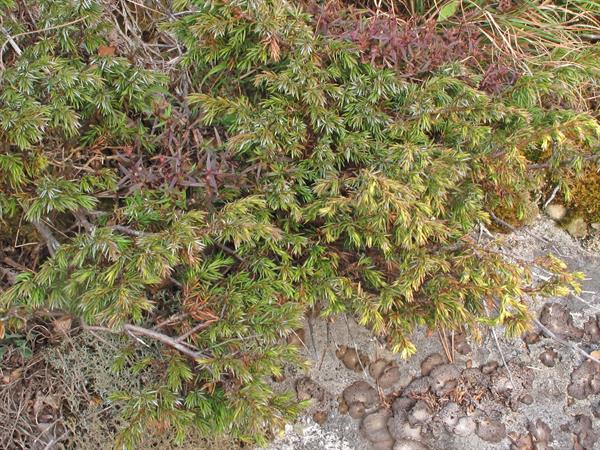
A genus of about 60 species, trees and shrubs, of temperate, boreal, and subtropical regions of the Northern Hemisphere. Various species of Juniperus, especially creeping species, are frequently used in landscaping. Molecular studies suggest that section Juniperus (J. communis in our area) and section Sabina are quite divergent (Adams & Demeke 1993). Small's (1933) recognition of the genus Sabina may prove to be warranted; some modern authors accept it (especially Europeans) and recent molecular evidence provides some support. Yang et al. (2022) reinitiated the idea that Sabina should be recognized at genus rank. "Sabina is easily distinguished from Juniperus s.s. based on morphology, i.e., presence of acicular leaves in Juniperus s.s. (vs. existence of both acicular and scale leaves in Sabina), acicular leaves having joints at the base in Juniperus s.s. (vs. no joints at the base in Sabina), terminal buds prominent in Juniperus s.s. (vs. inconspicuous in Sabina), seed scales ternately arranged in Juniperus s.s. (vs. decussately or ternately arranged in Sabina), and ovules between seed scales in Juniperus s.s. (vs. ovules inserted on the ventral side of seed scales in Sabina). Adams (2008) reconstructed a phylogeny using nrITS and plastome trnC-trnD sequences which supported a subdivision of the genus into three sections: sect. Caryocedrus Endl., sect. Juniperus, and sect. Sabina (Mill.) Spach. Mao et al. (2010) obtained a well-resolved phylogeny of Juniperus s.l. and confirmed these three sections. Adams (2008) tabulated the morphological differences between the three sections including the leaf shape, female cone size, female cone texture, and female cone color. Reproductive differences between the three sections were corroborated in Jagel and Dorken (2015). Considering the agreement between the phylogenetic results and the morphological differences, it seems reasonable to divide the genus Juniperus into three genera, Juniperus s.s. (sect. Juniperus), Sabina (sect. Sabina), and Arceuthos Antoine & Kotschy (sect. Caryocedrus). Arceuthos possesses winter terminal buds, leaves with a basal abscission zone, large female cones (18-25 mm) with 3 whorls of ternately arranged seed scales and seeds fused together in a hard bony-textured nut. Juniperus s.s. is similar to Arceuthos in the presence of winter terminal buds and basal abscission zone of leaves, having valvate seed scales and bearing one seed on each fertile scale, but differs from the latter in the female cone being smaller (6-15 mm vs. 18-25 mm in Arceuthos) and having three free seeds (vs. fused seeds in Arceuthos). Sabina is markedly distinguished from Arceuthos and Juniperus s.s. by having leaves decurrent down stem, female cones with peltate seed scales and free, unfused seeds, but lacking winter terminal buds and basal abscission zone (Adams, 2008, 2014)."
Ref: Adams (1986); Adams (1993) In Flora of North America Editorial Committee (1993b); Adams (1995); Adams (2008a); Adams (2008b); Adams (2008c); Adams (2008d); Adams (2014); Adams (2018); Adams & Demeke (1993); Adams & Schwarzbach (2012); Adams & Schwarzbach (2013a); Adams & Schwarzbach (2013b); Adams et al. (2016); Page In Kramer & Green (1990); Small (1933); Yang et al. (2022a). Show full citations.
Hover over a shape, letter, icon, or arrow on the map for definition or see the legend. Data for arrows not developed for genera and families which may have species only occurring outside the flora area.
 © Keith Bradley | Juniperus virginiana | Original Image ⭷
© Keith Bradley | Juniperus virginiana | Original Image ⭷ © Alan M. Cressler | Juniperus communis var. depressa | Original Image ⭷
© Alan M. Cressler | Juniperus communis var. depressa | Original Image ⭷ © Erik Danielson | Juniperus virginiana source | Original Image ⭷
© Erik Danielson | Juniperus virginiana source | Original Image ⭷ © Alan Cressler: Juniperus communis var. depressa, Satulah Mountain, Highlands-Cashiers Land Trust, Macon County, North Carolina 1 by Alan Cressler | Juniperus communis var. depressa source | Original Image ⭷
© Alan Cressler: Juniperus communis var. depressa, Satulah Mountain, Highlands-Cashiers Land Trust, Macon County, North Carolina 1 by Alan Cressler | Juniperus communis var. depressa source | Original Image ⭷Feedback
See something wrong or missing on about Juniperus? Let us know here: (Please include your name and email if at all complicated so we can clarify if needed.)
Cite as...